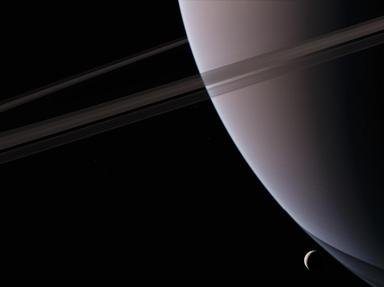Quiz Answer Key and Fun Facts
1. Saturn was the first planet known to have ____________.
2. Saturn's density is __________ that of water.
3. Saturn's mass is ______________ times that of the Earth.
4. What was the first spacecraft to visit Saturn?
5. Saturn takes approximately how many Earth years to make one revolution around the Sun?
6. Saturn is named (in Roman mythology) for the god of which of these?
7. Saturn's atmosphere is mostly ______________.
8. Saturn's rings are made up of individual small particles of rock and ice.
9. How thick are Saturn's rings?
10. The diameter of Saturn is _____________ kilometers.
11. The "dark" region between Saturn's two brightest rings is called ___________.
12. The largest satellite of Saturn is which of these?
13. There is a large impact crater on Saturn's moon Mimas, who is it named after?
14. Titan's atmosphere consists mainly of ____________.
15. Titan's northern hemisphere is slightly lighter than the southern hemisphere.
16. What is the name of the probe that will be sent into Titan's atmosphere? (This question was written in 2002)
17. What satellite of Saturn has very contrasting coloration?
18. What satellite of Saturn reflects almost all of the sunlight it receives?
19. Which of the following are satellites of Saturn?
20. Saturn is the _____________ largest planet in the Solar System.
Source: Author
almach
This quiz was reviewed by FunTrivia editor
crisw before going online.
Any errors found in FunTrivia content are routinely corrected through our feedback system.

